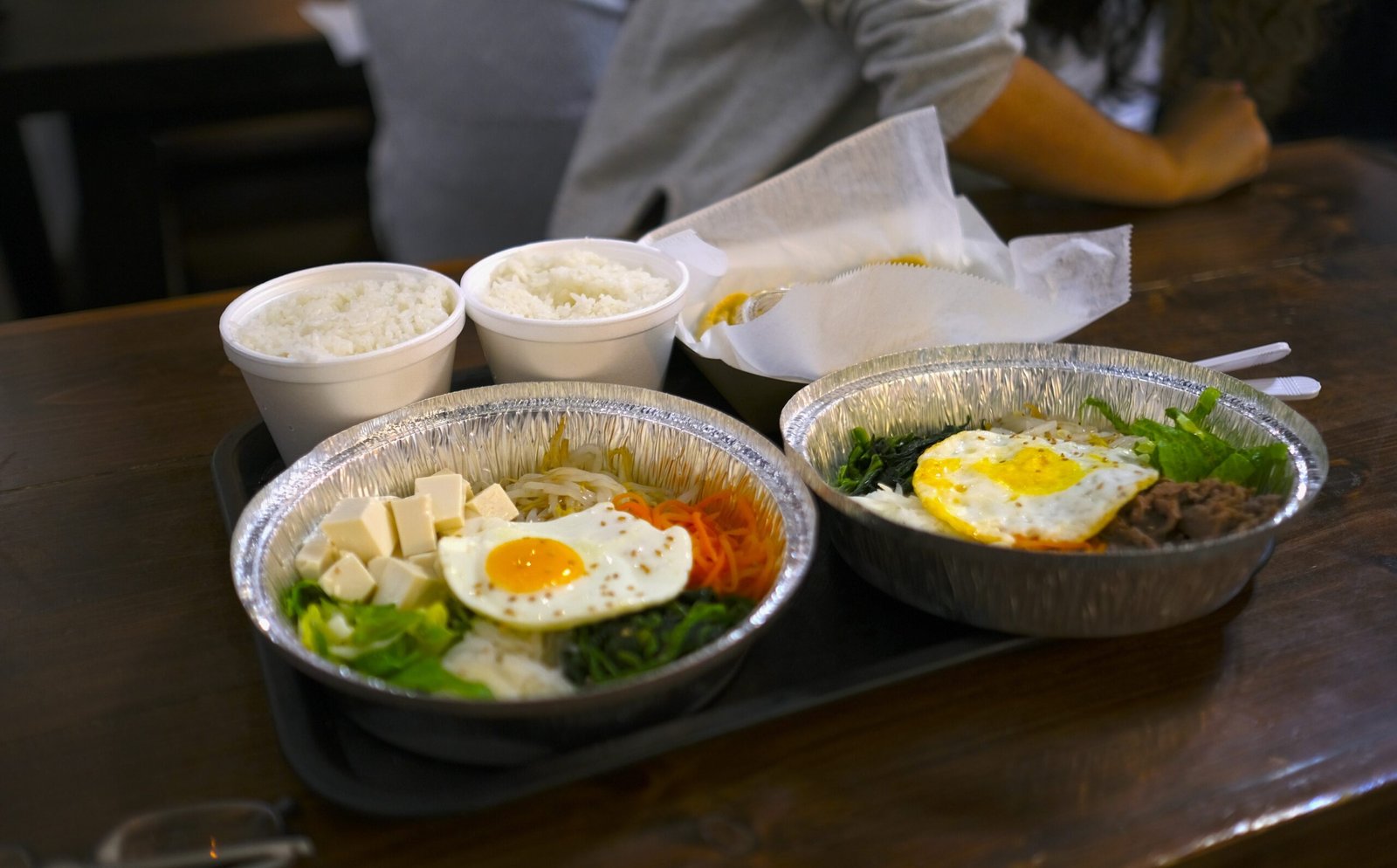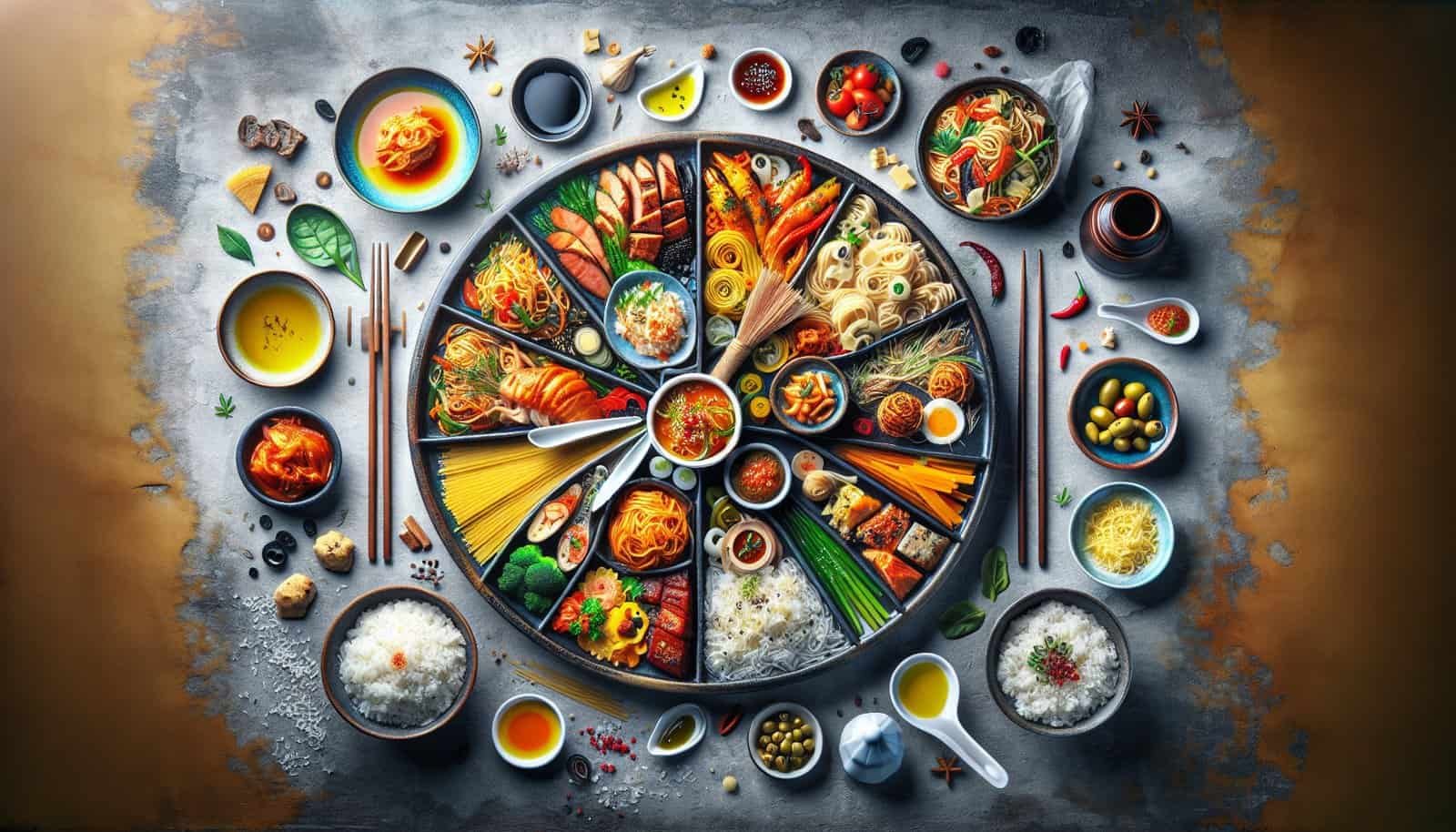Imagine a world where the flavors of Korea and international cuisines harmoniously blend together in a single dish, creating a tantalizing culinary experience. From the fiery spices of Korean cuisine to the rich flavors of international favorites, the possibilities are endless. But how exactly do you achieve this seamless fusion? In this article, we will explore the art of combining Korean and international flavors, uncovering the secrets behind creating a dish that embraces the best of both worlds. So get ready to embark on a delicious journey as we navigate the intricacies of fusing these two exceptional culinary traditions.
Understanding Korean Cuisine
Korean cuisine is known for its distinct flavors, vibrant colors, and diverse range of ingredients. Traditional Korean dishes often prioritize balance and harmony in both taste and presentation. Understanding the key ingredients and characteristics of Korean cuisine is essential when exploring fusion dishes.
Traditional Korean Ingredients
Traditional Korean ingredients form the foundation of Korean cuisine. These include staples such as rice, soy sauce, sesame oil, garlic, and ginger. Other commonly used ingredients include gochujang (a spicy red pepper paste), doenjang (fermented soybean paste), and gochugaru (red pepper flakes). These ingredients lend unique flavors and depth to Korean dishes.
Characteristics of Korean Dishes
Korean dishes are known for their bold flavors and use of contrasting textures. They often incorporate a variety of pickled, fermented, and spicy elements, resulting in a harmonious balance of sweet, spicy, sour, and savory flavors. Traditional Korean cooking techniques such as grilling, boiling, fermenting, and stir-frying further enhance the taste and texture profiles of dishes.
Popular Korean Dishes
Korean cuisine has gained immense popularity worldwide, largely due to its delicious and unique dishes. Some of the most well-known Korean dishes include:
Bibimbap: A colorful and nutritious dish consisting of rice topped with various seasoned vegetables, meat, and a fried egg, served with gochujang sauce.
Bulgogi: Thinly sliced marinated beef or pork, grilled to perfection and often enjoyed with rice or wrapped in lettuce leaves.
Kimchi: A staple in Korean cuisine, kimchi is a fermented side dish made from cabbage or radishes, seasoned with a variety of spices.
Japchae: Stir-fried glass noodles with vegetables and often accompanied by meat or seafood, resulting in a flavorful and satisfying dish.
Exploring International Cuisine
In addition to traditional Korean cuisine, exploring international cuisines opens up a world of possibilities for fusion dishes. Understanding popular international cuisines, their key ingredients, and flavors is crucial when blending them with Korean cuisine.
Popular International Cuisines
The world is full of diverse culinary traditions, each with its own unique flavors and techniques. Some of the popular international cuisines to explore when creating fusion dishes include:
Italian: Known for dishes like pasta, pizza, and risotto, Italian cuisine focuses on fresh ingredients, simplicity, and balance of flavors.
Mexican: Mexican cuisine is famous for its vibrant use of flavors such as chili peppers, tomatoes, corn, and various herbs and spices.
Japanese: With its emphasis on fresh seafood, rice, and delicate flavors, Japanese cuisine offers a wide range of possibilities for fusion dishes.
Key Ingredients and Flavors
When fusing Korean and international cuisines, identifying key ingredients and flavors common to both becomes important. For example, ingredients like garlic, soy sauce, and sesame oil are used in both Korean and many other international cuisines. Flavors such as umami, sweetness, and heat can also be found in various cuisines, providing a basis for harmonious fusion.
Innovations in International Dishes
The world of international cuisine is constantly evolving, with chefs and home cooks alike experimenting with innovative techniques and flavors. From modern twists on traditional dishes to fusion experiments, innovations in international cuisine provide inspiration for incorporating Korean elements into these dishes.

Finding Common Ground
Finding common ground between Korean and international cuisines lays the foundation for successful fusion dishes. This involves identifying shared ingredients, recognizing complementary flavors, and understanding cooking techniques used in both culinary traditions.
Identifying Shared Ingredients
Korean and international cuisines often share common ingredients, despite their cultural differences. Garlic, onions, ginger, and various herbs and spices are commonly used in different cuisines. Identifying these shared ingredients allows for seamless integration when creating fusion dishes.
Recognizing Complementary Flavors
Flavors that complement each other can enhance the harmony of fusion dishes. Korean cuisine’s range of bold and spicy flavors can pair well with the rich, creamy elements of international dishes. For example, the heat of kimchi can be balanced with the creaminess of cheese in fusion creations.
Understanding Cooking Techniques
Both Korean and international cuisines have unique cooking techniques that contribute to the character of their dishes. Grilling, stir-frying, and fermenting are common in Korean cuisine, while roasting, sautéing, and braising are techniques used in many international dishes. Understanding and combining these techniques can result in innovative fusion creations.
Blending Flavors and Techniques
Blending Korean ingredients and flavors with international dishes, and vice versa, allows for exciting fusion cuisine. Experimenting with techniques and flavors can lead to delightful new combinations that highlight the best of both culinary traditions.
Using Korean Ingredients in International Dishes
Incorporating Korean ingredients into international dishes adds a unique twist that elevates the flavors. For example, adding gochujang to a traditional pasta sauce can infuse it with a spicy and robust kick. Similarly, using Korean soy sauce and sesame oil in an Italian-inspired salad dressing can introduce new dimensions of flavor.
Incorporating International Ingredients in Korean Dishes
Introducing international ingredients into Korean dishes provides an opportunity to explore new flavors and textures. For instance, adding coconut milk to a Korean-style curry can create a fusion dish with a tropical twist. Experimenting with international spices and herbs can also enhance the complexity of traditional Korean dishes.
Experimenting with Fusion Techniques
In fusion cuisine, the possibilities are endless. Experimenting with different techniques and combinations allows for the creation of unique and exciting dishes. For example, combining Korean barbecue flavors with the concept of Mexican tacos can result in delicious and innovative creations like kimchi tacos.

Case Studies: Successful Korean-International Fusion Dishes
Several fusion dishes have gained popularity for their successful blending of Korean and international cuisines. These case studies highlight the versatility and creativity that fusion cuisine offers.
Kimchi Tacos
Kimchi tacos have gained acclaim in recent years, blending the spicy and tangy flavors of traditional Korean kimchi with the concept of Mexican tacos. The combination of the flavorful marinated meats with the crunch of fresh vegetables and the heat of kimchi creates a truly unique and delicious fusion dish.
Bulgogi Pizza
Bulgogi pizza is a fusion dish that combines the beloved Korean marinated beef, bulgogi, with the Italian classic, pizza. The tender bulgogi adds a savory and sweet element to the pizza, while the melted cheese and crispy crust provide the perfect canvas for these bold flavors to shine.
Bibimbap Sushi Rolls
Bibimbap sushi rolls bring together the freshness of Japanese sushi with the vibrant colors and flavors of Korean bibimbap. The rolls typically feature a combination of marinated vegetables, meat, and a touch of gochujang, all wrapped in sheets of nori seaweed and rice. This fusion dish offers a delightful mix of textures and tastes.
Korean Fried Chicken Sandwich
The Korean fried chicken sandwich takes the crispy and flavorful Korean fried chicken and places it between two slices of bread, creating a fusion take on a classic sandwich. With the addition of pickles, lettuce, and a spicy sauce, this fusion dish combines the best of Korean flavors with the convenience and comfort of a sandwich.
Balancing Spices and Flavors
Achieving a harmonious balance of spices and flavors is crucial when creating fusion dishes. Striking the right balance allows the individual elements to shine while creating a cohesive and delicious final product.
Adjusting Spice Levels
Spice levels can be adjusted to suit personal preferences when fusing Korean and international flavors. By reducing or increasing the amount of spicy ingredients like gochujang or chili peppers, the heat can be tailored to individual tastes. Gradually adding spices and tasting along the way ensures that the desired level of spiciness is achieved.
Adding Sweet and Savory Elements
Combining sweet and savory elements is a common theme in both Korean and international cuisines. In fusion dishes, sweet and savory flavors can be balanced to create a harmonious blend. For example, adding a touch of brown sugar to a Korean-inspired marinade for international-style grilled meat can create a delightful balance of sweetness and umami.
Enhancing Umami Flavors
Umami, often described as the fifth taste, plays a significant role in both Korean and international cuisines. Bold umami flavors can be enhanced by incorporating ingredients such as fermented soybean paste, fish sauce, or mushrooms into fusion dishes. This boosts the depth and richness of the final dish.

Presentation and Aesthetics
In addition to flavors, the presentation and aesthetics of fusion dishes play a crucial role in creating a memorable dining experience. Drawing from traditional Korean plating techniques and adding innovative arrangements adds visual appeal and further enhances the overall dining experience.
Incorporating Traditional Korean Plating Techniques
Traditional Korean cuisine places great emphasis on aesthetics and presentation. Incorporating elements such as banchan (side dishes), vibrant colors, and intricate garnishes can add an authentic touch to fusion dishes. Arranging different components of the dish with attention to detail and balance creates an inviting and visually pleasing plate.
Innovative Plating Arrangements
Fusion cuisine allows for experimenting with unique plating arrangements that blend Korean and international styles. For example, arranging Korean-style bulgogi on a bed of Italian-inspired risotto can create an intriguing combination of flavors and textures. Playing with different shapes, sizes, and heights of the components creates visual interest and adds an element of creativity to the dish.
Creating Visually Appealing Dishes
In fusion cuisine, the visual appeal of a dish is as important as its taste. By considering color contrasts, textures, and incorporating decorative elements, fusion dishes can become visually stunning. Vibrant vegetables, delicate garnishes, and carefully placed sauces contribute to the overall aesthetic appeal of the dish.
Cultural Sensitivity and Respect
When fusing Korean and international cuisines, it is important to approach the process with cultural sensitivity and respect. Understanding the cultural context of both culinary traditions and avoiding cultural appropriation are essential to creating fusion dishes that celebrate the best of both worlds.
Understanding Cultural Context
Each cuisine carries its own cultural significance and history. Understanding the cultural context behind the dishes being fused helps provide deeper appreciation and respect for both culinary traditions. Learning about traditional cooking techniques, culinary customs, and the symbolism behind certain ingredients can help create fusion dishes that honor the cultural heritage they come from.
Avoiding Cultural Appropriation
Cultural appropriation involves taking elements of a culture without proper understanding or respect. When fusing Korean and international cuisines, it is essential to be mindful of not appropriating elements from either culture. Instead, aim to create dishes that are a genuine fusion, respecting the integrity of the culinary traditions being combined.
Celebrating Fusion without Dilution
Fusion cuisine should be a celebration of diversity and cultural exchange, rather than a dilution of individual culinary traditions. While embracing new flavors and techniques, it is important to ensure that the essence of each cuisine is preserved and showcased. By combining Korean and international elements in a harmonious way, fusion dishes can become a testament to the strengths and beauty of both culinary traditions.

Embracing Creativity and Experimentation
Creativity and experimentation are at the heart of fusion cuisine. Embracing new ideas and unusual combinations can lead to exciting culinary discoveries and delightful fusion dishes that push boundaries.
Taking Inspiration from Different Cuisines
Drawing inspiration from a wide range of culinary traditions can spark creativity when fusing Korean and international cuisines. Exploring flavors, techniques, and ingredients from various cuisines provides a broader palette to work with and opens up new possibilities for creating unique fusion dishes.
Trying Unusual Ingredient Combinations
In fusion cuisine, trying unusual ingredient combinations can lead to exceptional flavor profiles. Combining seemingly incompatible ingredients can yield surprising results. For example, pairing Korean gochujang with tropical fruits like mango creates a complex and intriguing balance of spiciness and sweetness.
Pushing Boundaries with Fusion Techniques
Fusion techniques allow for pushing boundaries and creating dishes that challenge traditional notions of culinary boundaries. Experimenting with techniques such as sous vide cooking, smoking, or molecular gastronomy can add a modern twist to fusion dishes. Pushing the limits and embracing innovation can result in memorable and boundary-breaking fusion creations.
Building Bridges through Food
Food has the power to bridge cultural divides and foster cross-cultural understanding. Using fusion cuisine as a medium for cultural exchange promotes appreciation and respect for different culinary traditions, ultimately bringing people together through food.
Promoting Cross-Cultural Understanding
Fusion cuisine serves as a platform for promoting cross-cultural understanding by bringing together diverse culinary traditions. By embracing the uniqueness of each cuisine and highlighting their shared ingredients and techniques, fusion dishes encourage dialogue, curiosity, and appreciation for different cultures.
Using Food as a Medium for Cultural Exchange
Food acts as a universal language that transcends cultural boundaries. Through fusion cuisine, different culinary traditions can be celebrated and shared, creating opportunities for individuals from different cultural backgrounds to come together and learn from one another. By sharing fusion dishes, individuals can gain a deeper understanding of the rich and diverse world of food.
Exploring New Culinary Horizons
Fusion cuisine opens up new culinary horizons by encouraging exploration and experimentation. By pushing the boundaries of traditional dishes and combining diverse culinary traditions, fusion cuisine inspires individuals to broaden their culinary experiences and embrace diversity in flavors, ingredients, and techniques. This exploration fosters a sense of openness and curiosity, creating a more inclusive and dynamic food culture.
In conclusion, fusing Korean and international cuisines in a single dish requires an understanding of the key ingredients, flavors, and techniques of both culinary traditions. By finding common ground, blending flavors and techniques, and embracing creativity, fusion dishes can bring together the best of Korean and international cuisines. With cultural sensitivity and respect, fusion cuisine becomes a celebration of diversity and a means to bridge cultural divides. Through food, individuals can explore new culinary horizons and build connections that transcend borders. So, go ahead and embark on a culinary journey where the possibilities are endless and the flavors abound.

